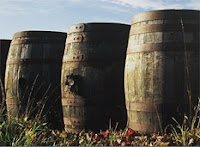 The art of making whisky casks is a highly skilled and traditional practice called coopering. Nowadays, modern machinery aids the cooper (the name given to someone who makes casks and barrels) but it still takes years of training to reach the required industry standards. But how are these casks made? Here we will go through the process of this dying craft.
The art of making whisky casks is a highly skilled and traditional practice called coopering. Nowadays, modern machinery aids the cooper (the name given to someone who makes casks and barrels) but it still takes years of training to reach the required industry standards. But how are these casks made? Here we will go through the process of this dying craft.• Oak trees are only cut down when they have reached sufficient maturity. This is when the tree is roughly 7.5 metres (25 feet) tall and 1 metre (3 feet) in diameter.
• The trunks are transferred to a sawmill. Here they are sawn into planks from which the correct length of stave are cut. A stave is a small plank with a sophisticated curved surface that links together to form a circular barrel.
• Traditionally a cask is formed of 32 staves with 15 more being used to seal the ends.
• In order to bend the staves to the correct shape, they are exposed to fire. Also, most bourbon distilleries in America deliberately char the inside of the casks as a common practice. This is done to help with the penetration of the spirit into the wood.
• A cooper planes down the staves so that they fit together tightly without leaking. This is done naturally without the use of nails or any glue and the staves are held securely in place by metal hoops.
• Wood is a porous material and the distillers want the whisky to interact with the air. Therefore, no varnish or paints are used on the casks to allow the wood to ‘breathe’.
• A hole is then drilled in the side in order to allow easy checking on the progress of the whisky’s maturation and final emptying.

No comments:
Post a Comment